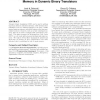CASES
2008
ACM
14 years 9 months ago
2008
ACM
Dynamic binary translators (DBT) have recently attracted much attention for embedded systems. The effective implementation of DBT in these systems is challenging due to tight cons...
CGO
2004
IEEE
14 years 10 months ago
2004
IEEE
Dynamic optimization systems store optimized or translated code in a software-managed code cache in order to maximize reuse of transformed code. Code caches store superblocks that...
DAC
2009
ACM
14 years 11 months ago
2009
ACM
Dynamic binary translation (DBT) can be used to address important issues in embedded systems. DBT systems store translated code in a software-managed code cache. Unlike general-pu...
IEEEINTERACT
2002
IEEE
15 years 23 hour ago
2002
IEEE
A dynamic optimizer is a software-based system that performs code modifications at runtime, and several such systems have been proposed over the past several years. These systems ...
MICRO
2003
IEEE
15 years 11 days ago
2003
IEEE
Many dynamic optimization and/or binary translation systems hold optimized/translated superblocks in a code cache. Conventional code caching systems suffer from overheads when con...
MICRO
2003
IEEE
15 years 11 days ago
2003
IEEE
A dynamic optimizer is a runtime software system that groups a program’s instruction sequences into traces, optimizes those traces, stores the optimized traces in a softwarebase...
CGO
2005
IEEE
15 years 22 days ago
2005
IEEE
Software code caches are becoming ubiquitous, in dynamic optimizers, runtime tool platforms, dynamic translators, fast simulators and emulators, and dynamic compilers. Caching fre...
CGO
2006
IEEE
15 years 1 months ago
2006
IEEE
Software code caches help amortize the overhead of dynamic binary transformation by enabling reuse of transformed code. Since code caches contain a potentiallyaltered copy of ever...
HIPEAC
2007
Springer
15 years 1 months ago
2007
Springer
Abstract. The interest in translation-based virtual execution environments (VEEs) is growing with the recognition of their importance in a variety of applications. However, due to ...
IISWC
2008
IEEE
15 years 1 months ago
2008
IEEE
Dynamic binary translation systems enable a wide range of applications such as program instrumentation, optimization, and security. DBTs use a software code cache to store previou...



